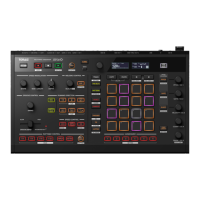
Do you have a question about the PIONEER DJ Toraiz Squid and is the answer not in the manual?
| Brand | PIONEER DJ |
|---|---|
| Model | Toraiz Squid |
| Category | Recording Equipment |
| Language | English |
Details the SQUID's capabilities, including multitrack sequencing, phrase arrangement, and connectivity.
Explains the auto power off feature, how to enable/disable it, and its implications for saved data.
Details the SHIFT, record, stop, play, TAP, GLOBAL, BACK, Rotary selector, and TIME WARP buttons.
Explains controls for Speed Modulation, Melodic Control, Groove Control, Running Direction, Speed Control, and Rhythmic Control.
Details controls for TRACK, TRK MUTE, PATTERN, SCALE, TRANSPOSE, TRIGGER, TIE, and ACTIVE modes.
Describes the DC IN, USB, MIDI, CV/GATE, CLOCK, and DIN SYNC terminals, along with the power button.
Illustrates how to connect MIDI, DIN SYNC, CV/GATE/CLOCK devices, and a PC/Mac.
Explains the procedure for securing the AC adapter cable using the unit's cable hook.
Covers creating, loading, saving, overwriting, renaming, and deleting projects.
Explains how to play, pause, and stop sequences using the Global section transport buttons.
Details the different modes for the 16-pads, including Track, Pattern, Scale, Chord, and Trigger modes.
Explains how to select and edit individual tracks using the 16-pads.
Describes how to mute and solo individual tracks using the 16-pads.
Details how to load, save, and delete patterns using the 16-pads.
Explains how to save and load combinations of patterns as pattern sets.
Covers playing scales using the 16-pads and changing the note range.
Explains how to play chords and set chord set numbers using the 16-pads.
Details how to transpose the current pattern in real-time using the 16-pads.
Explains step recording, parameters per step, COUNT and DIVIDE values, and TIE/ACTIVE settings.
Describes how to assign and sequence MIDI control values using the 16-pads.
Explains how to set the tie of each step to connect sounds from previous steps.
Details setting CV Slide for steps to smoothly change pitch values between steps.
Explains how to set steps to Active or Inactive, skipping inactive steps during playback.
Describes interpolating parameters (Pitch, Gate, Velocity) between beginning, middle, and end points.
Explains randomizing mute/unmute, Pitch, Gate, Velocity, or control values for steps.
Details playing chords based on the PITCH value as the root, applied to steps.
Explains copying and pasting steps, patterns, and notes.
Covers deleting automation, initializing steps, and deleting patterns or pattern sets.
Explains shifting all steps forwards or backwards within a pattern.
Describes moving the playback position to a specific step by pressing a pad.
Explains automatically fixing the pattern length to a predetermined number of beats.
Details fluctuating playback speed to create unique grooves using Shape, Mod Length, and Depth.
Covers changing scale/key and using the Arpeggiator to alter phrase atmosphere.
Explains creating grooves by altering trigger timing using Swing and Groove Bend.
Details changing playback direction (forward, reverse, switch back) of sequences.
Explains changing playback speed (1/2X, 2X) and using Nudge for beat matching.
Details creating fill-ins and phrases by looping parts or changing trigger probability.
Allows undoing up to 16 past operations and restoring the unit to a previous state.
Enables auto-recording and playback of previously played patterns as new patterns.
Guide to accessing and modifying various unit settings through the GLOBAL menu.
Explains how to correct trigger timing imperfections and set quantization values.
Details how to set Arpeggiator Rate, Style, Range, and Gate Length.
Explains how to set the probability of triggers for each step in a pattern.
Covers changing track name, mono/poly settings, track speed, and track colors.
Details selecting and customizing chord types for the Harmonizer buttons.
Explains how to set the fixed length of a pattern in beats.
Guide to connecting the unit via MIDI OUT or USB-B to external MIDI devices or computers.
Details synchronized playback using MIDI messages as master or slave devices.
Explains connecting synthesizers or sound modules using CV/GATE signals.
Details synchronizing the unit with DIN SYNC devices using timing clock and control signals.
Explains synchronizing with devices using CLOCK signals for timing and control.
Covers timing clock rate conversion and CV/GATE conversion between different formats.
Provides solutions for power issues, unstable operation, and general problems.
Lists trademark information for Pioneer DJ Corporation and other companies.